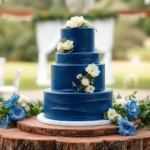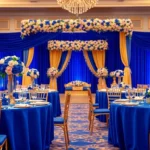Packing a stunning lehenga for your wedding festivities can feel overwhelming when you’re worried about wrinkles creases and damage during travel. We understand how precious these ornate garments are – they’re not just outfits but cherished pieces that hold immense sentimental and monetary value.
Whether you’re traveling to your destination wedding or need to transport multiple lehengas for different ceremonies we’ve discovered foolproof packing techniques that’ll keep your ensembles pristine. The right packing strategy can mean the difference between stepping out in a flawless lehenga and spending precious wedding prep time dealing with damaged fabric or missing embellishments.
We’ll share professional packing methods that bridal stylists and destination wedding experts swear by. From choosing the perfect garment bags to layering techniques that prevent crushing we’ve compiled insider secrets that ensure your lehengas arrive looking exactly as they did when you first fell in love with them.
Essential Packing Materials for Your Wedding Lehenga
Professional packing materials make the difference between arriving with pristine wedding attire or dealing with last-minute damage. We recommend investing in quality supplies that protect your lehenga’s delicate fabrics and intricate embellishments.
Garment Bags and Covers
Breathable garment bags serve as your lehenga’s first line of defense against dust, moisture, and wrinkles during transport. Cotton or muslin garment covers allow air circulation while preventing fabric from developing musty odors during long trips. We suggest avoiding plastic bags completely since they trap moisture and can cause mildew or fabric discoloration.
Full-length garment bags accommodate the complete lehenga ensemble including the blouse, skirt, and dupatta without bunching. Professional-grade bags feature reinforced zippers and sturdy handles that withstand frequent handling during travel. Transparent panel sections let you identify contents quickly without opening multiple bags during unpacking.
Tissue Paper and Acid-Free Materials
Acid-free tissue paper prevents color bleeding and fabric degradation when layered between lehenga components. White tissue paper works best since colored versions can transfer dye onto light-colored fabrics during humid conditions. We recommend using at least 3-4 sheets between each garment piece to create adequate cushioning.
Archival-quality materials maintain fabric integrity over extended periods and won’t yellow or deteriorate like regular tissue paper. Buffered tissue paper neutralizes acids that naturally develop in storage environments. Museum-grade supplies cost more initially but protect valuable wedding lehengas from long-term damage that could require expensive restoration.
Padded Hangers and Support Systems
Padded hangers distribute weight evenly across the lehenga blouse’s shoulder area and prevent stretching or distortion. Velvet-covered hangers grip delicate fabrics without slipping while the padding prevents indentations from forming along seam lines. We avoid wire hangers entirely since they can snag embellishments or create permanent creases.
Cedar hangers naturally repel insects and absorb excess moisture that could damage silk or cotton fabrics. Adjustable hanger systems accommodate different blouse sizes and allow you to customize the fit for each garment. Clip attachments secure dupatta edges without leaving marks while skirt hangers with adjustable clips distribute the lehenga’s weight properly.
Folding Techniques to Prevent Wrinkles and Damage
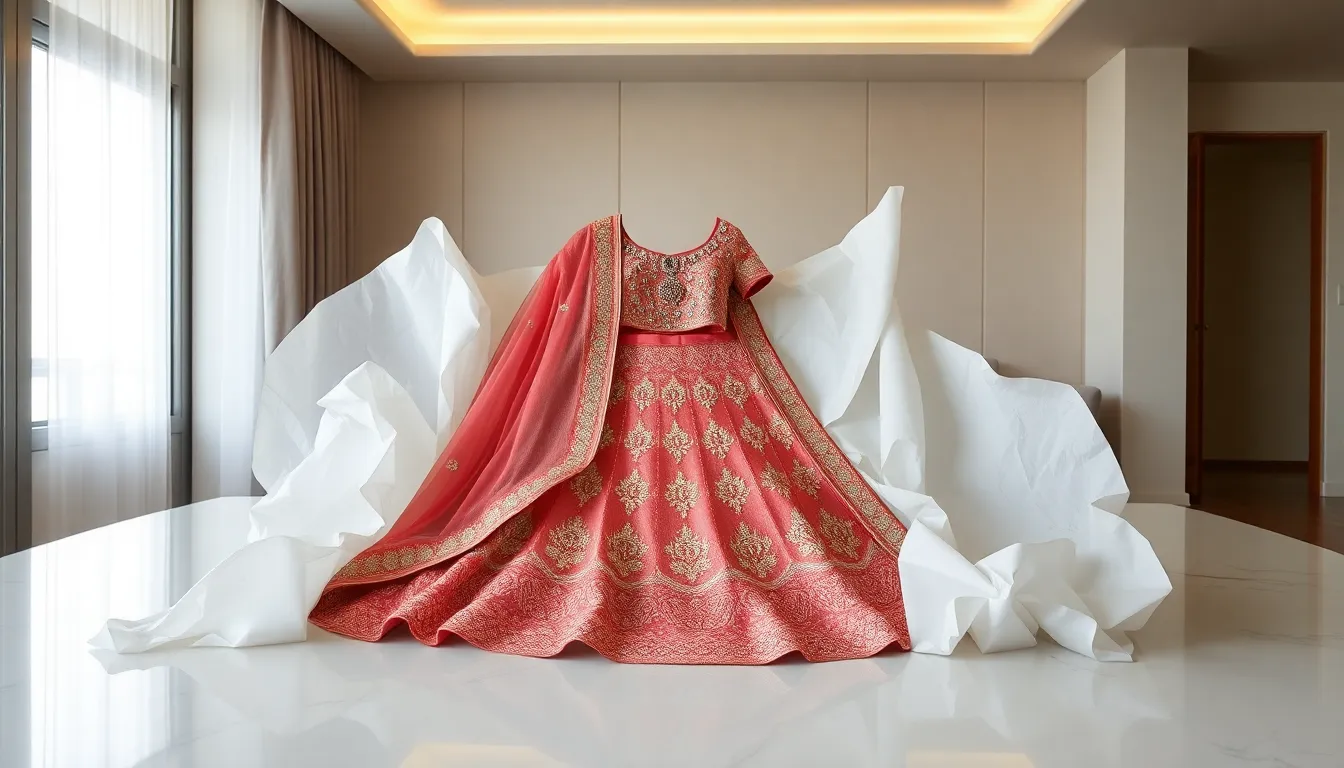
Proper folding techniques make the difference between arriving with a pristine lehenga and dealing with unwanted creases on your special day. We’ll share three proven methods that protect your garments while maximizing suitcase space.
The Flat Lay Method for Heavy Lehengas
Heavy lehengas require special attention due to their weight and elaborate embellishments. We recommend laying your lehenga completely flat on a clean bed or large surface before beginning the folding process. Start by gently tucking in any protruding embellishments like beads, sequins, or threads to prevent snagging during transport.
Fold the lehenga lengthwise with extreme care, ensuring the fabric lies smoothly without bunching. This method works particularly well for heavily embellished pieces that are prone to creasing under their own weight. Wrap the folded lehenga in acid-free tissue paper to create a protective barrier around delicate decorations and prevent fabric-to-fabric contact that could damage embroidery.
Rolling Technique for Lightweight Fabrics
Rolling offers superior wrinkle prevention for lightweight lehenga fabrics like georgette, chiffon, and silk. We find this technique especially effective because it distributes tension evenly across the fabric rather than creating sharp fold lines.
Begin by laying your lightweight lehenga flat and smoothing out any existing wrinkles with your hands. Roll the garment from the waistband toward the hem, maintaining consistent pressure throughout the process. Keep the roll tight enough to prevent shifting but gentle enough to avoid crushing delicate fabrics.
Store rolled lehengas in breathable cotton garment bags to maintain their shape during travel. This method works best for fabrics that naturally resist creasing and don’t have heavy embellishments that could create lumps in the roll.
Layer-by-Layer Folding Strategy
Strategic layering helps organize complex lehenga sets while preventing fabric bunching and embellishment damage. We recommend starting this process from the bottom hem and working systematically toward the waistband.
Create your first fold approximately one-third up from the hem, ensuring the fabric lies completely flat before proceeding. Make your second fold at the two-thirds mark, checking that embellishments aren’t trapped between layers. Finish by folding the waistband section over the previous layers, creating a compact rectangular package.
Place tissue paper between each layer to prevent color transfer and protect embellishments from pressing against each other. This organized approach keeps folds neat and prevents the chaotic bunching that often occurs with hasty packing methods.
Protecting Embellishments and Delicate Details
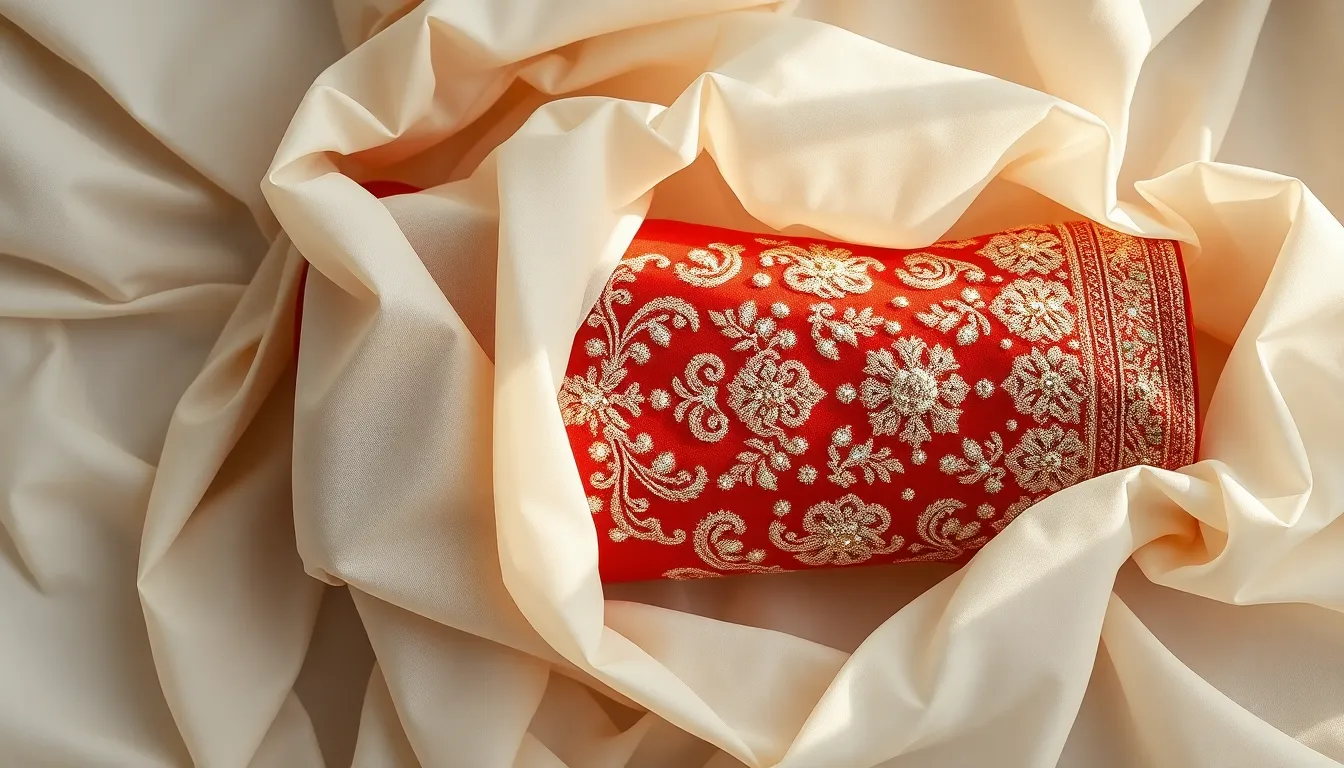
Intricate beadwork and sequined details make lehengas stunning but require special attention during packing. We’ll share proven techniques to safeguard these delicate elements from damage during transport.
Separating Beaded and Sequined Areas
Layer tissue paper between embellished sections to prevent beads and sequins from catching on each other. We recommend using soft tissue paper or cloth to create protective barriers that cushion delicate areas. Place thin cotton fabric over heavily beaded portions before folding to distribute pressure evenly across the surface.
Position embellished areas face up when possible to minimize contact with other fabric layers. This technique prevents sequins from pressing into the base fabric and creating permanent indentations. We’ve found that alternating tissue paper layers between beaded sections reduces friction that can loosen delicate threads.
Using Soft Cloth Barriers
Wrap your lehenga in muslin or silk cloth to create an effective barrier against dust and moisture. These breathable fabrics protect embellishments while allowing air circulation that prevents mildew formation. We prefer white muslin because it won’t transfer color onto light colored lehengas.
Cover the entire ensemble with soft cloth before placing it in garment bags or storage boxes. This extra layer shields delicate details from zippers, bag seams, and other potential snag points. Cotton voile works exceptionally well for this purpose because it’s lightweight yet protective.
Insert cloth padding around areas with protruding embellishments like 3D flowers or raised beadwork. We use small pieces of soft cotton to cushion these elements and prevent them from flattening during transport.
Securing Loose Elements
Check for loose sequins and beads before packing by gently running your fingers along embellished areas. We recommend tightening any loose threads with a small needle and matching thread to prevent further damage during transport. Document areas that need professional repair after the event.
Tack down any hanging elements like tassels, dangles, or decorative chains with temporary stitches. This prevents them from tangling with other parts of the lehenga or catching on bag zippers. We use contrasting thread colors for easy removal later.
Secure detachable accessories like dupattas with loose embellishments by wrapping them separately in tissue paper. Bundle these items together with soft ties rather than rubber bands that can leave marks on delicate fabrics.
Smart Packing Order for Multiple Wedding Outfits
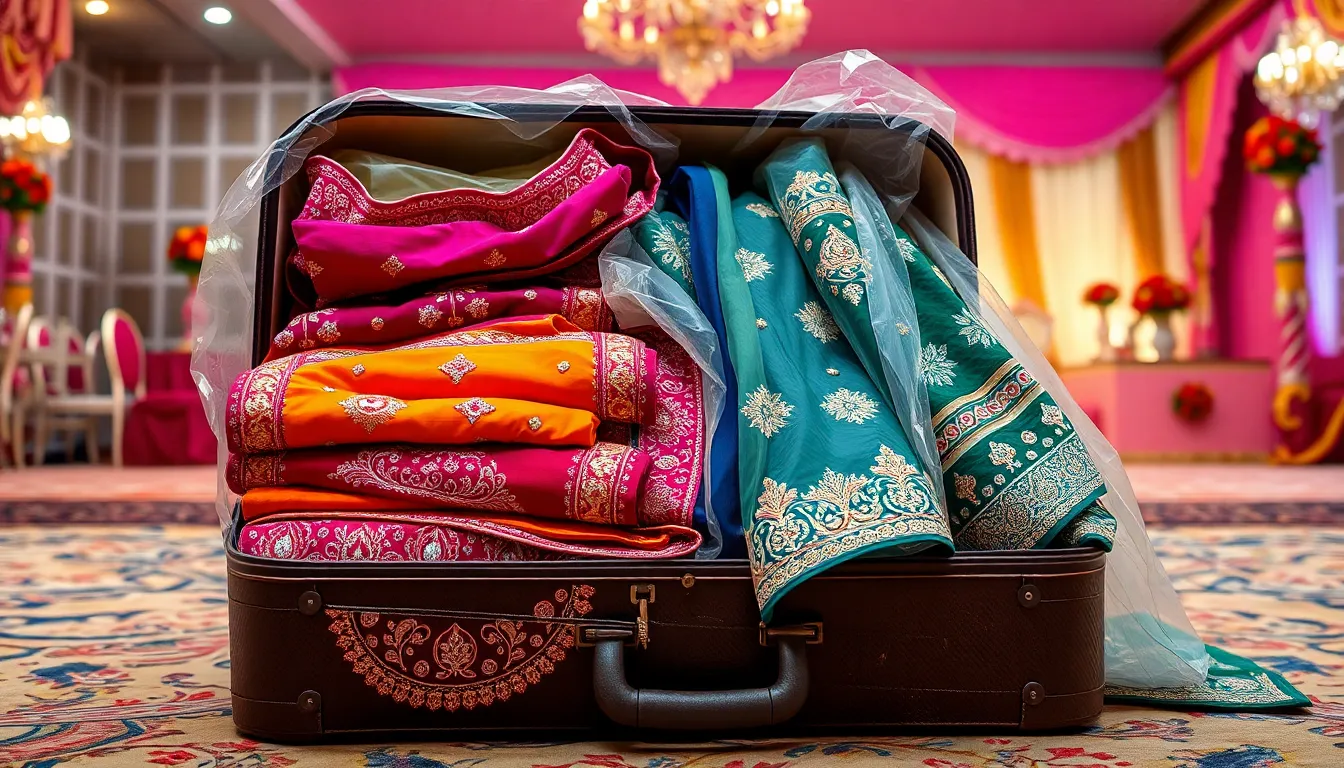
Organizing multiple wedding outfits requires strategic planning to ensure each piece arrives in perfect condition. We’ll share the essential packing sequence that prevents damage and maintains easy access to your lehengas throughout wedding festivities.
Heaviest Items at the Bottom
Placing heavyweight lehengas at the bottom of your luggage prevents crushing lighter garments. We recommend starting with heavily embellished or brocade lehengas that feature substantial fabrics and extensive beadwork. These pieces can withstand more weight without developing permanent creases or structural damage.
Silk and velvet lehengas with heavy zardozi work should form your base layer. Their dense construction provides a stable foundation for layering additional outfits. We’ve found that this technique prevents lighter fabrics like chiffon and georgette from getting compressed during transport.
Consider the weight distribution across your entire luggage when stacking outfits. Balance is key to preventing one side from becoming too heavy, which could shift contents during travel and cause unwanted wrinkles.
Creating Protective Layers
High quality garment bags provide the first line of defense against dust, moisture, and wrinkles. We recommend investing in breathable cotton or muslin garment bags that allow air circulation while protecting your lehengas from environmental damage.
Acid free tissue paper creates essential barriers between delicate fabrics. Wrap silk and chiffon lehengas in this specialized paper to prevent color bleeding and fabric deterioration. The archival quality material ensures your garments remain pristine throughout extended storage periods.
Breathable covers offer additional protection without trapping harmful moisture. These covers work particularly well for destination weddings where climate changes might affect fabric integrity. We suggest using cotton dust covers that provide protection while allowing proper ventilation.
Organizing by Event Schedule
Arrange outfits according to your wedding timeline so the first ceremony’s lehenga stays easily accessible. We recommend placing your mehendi or sangeet outfit on top, followed by the reception and wedding day ensembles in reverse chronological order.
Label each garment bag with the corresponding event and date. This system prevents last minute searching through multiple bags when you’re getting ready. We’ve seen too many brides stress about finding exact outfits during busy wedding preparations.
Pack accessories for each event in separate compartments within the same garment bag. Jewelry, shoes, and dupattas should travel together with their matching lehenga to ensure complete coordination. This approach eliminates the possibility of forgetting essential elements for any particular ceremony.
Travel-Friendly Lehenga Packing Solutions
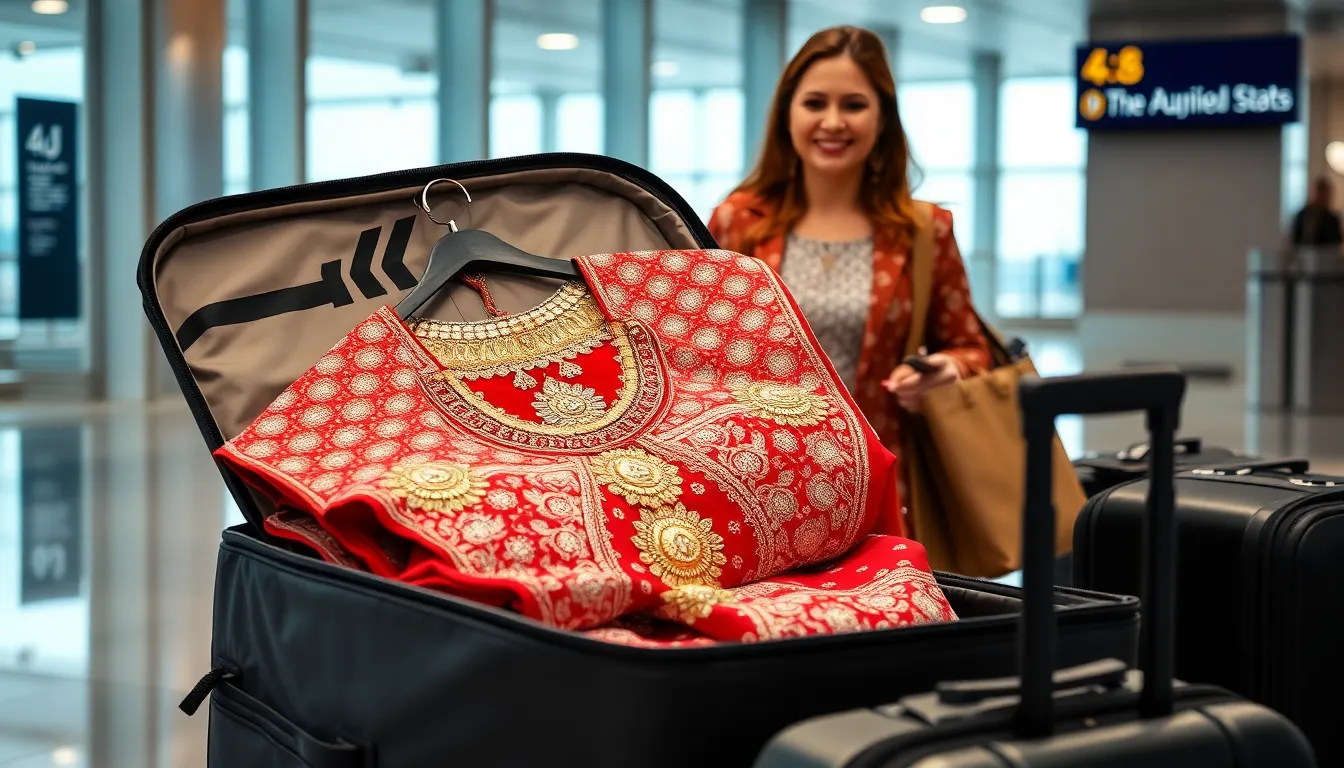
Choosing the right luggage strategy becomes crucial when traveling with precious wedding lehengas. We need to consider airline policies and travel distances to make informed decisions about protecting these valuable garments.
Carry-On vs. Checked Luggage Considerations
Carry-on advantages make it our preferred choice whenever possible since keeping lehengas with us minimizes risk of heavy handling or loss. Airlines handle carry-on bags more gently compared to checked luggage that goes through multiple conveyor systems and loading processes.
Weight restrictions often limit what we can pack in carry-on compartments, so we must prioritize our most valuable pieces. Blouses and dupattas typically travel well in overhead bins while leaving room for essential accessories.
Checked luggage precautions require extra protection when we can’t avoid separating from our lehengas. Using robust breathable garment bags inside hard-shell suitcases provides double protection against crushing and environmental damage.
Security measures help us track our garments by photographing each piece before packing and keeping receipts readily available. Documentation proves invaluable if airlines misplace our luggage during connecting flights or transfers.
Portable Garment Bags for Flights
High-quality garment bags designed specifically for Indian wedding wear protect against dust, moisture, and wrinkles during flights. We recommend investing in bags with reinforced zippers and transparent identification panels for easy recognition.
Breathable covers prevent moisture buildup that can damage delicate fabrics and embellishments over long flights. Cotton or muslin materials allow air circulation while keeping lehengas safe from environmental contaminants.
Folding compatibility ensures garment bags accommodate our carefully folded lehengas without compromising the protective tissue paper layers. Bags should expand enough to house the entire ensemble without creating pressure points on embellished areas.
Airline compliance requires checking exact carrier restrictions before selecting garment bags for travel. Some airlines have size limitations that affect which protective bags we can use in different luggage compartments.
International Travel Requirements
Fabric documentation helps customs officials understand the cultural significance and value of our wedding attire when crossing international borders. Carrying clear photos and receipts can expedite security checks and prevent unnecessary delays.
Climate adaptation becomes essential when traveling between different weather zones with delicate lehenga fabrics. We use acid-free tissue paper and moisture-absorbing packets to maintain fabric integrity across varying humidity levels.
Airline restrictions vary significantly between international carriers, so we check weight limits and size requirements beforehand. Planning allows us to split lehenga components between carry-on and checked bags when necessary.
Portable steamers provide immediate wrinkle removal upon arrival, ensuring our lehengas look camera-ready for wedding functions. Compact travel steamers work effectively on heavy embroidered fabrics without causing damage to delicate embellishments.
Extended travel considerations require additional protective measures for journeys lasting more than 12 hours. We pack mini emergency kits containing safety pins, travel sewing supplies, and fashion tape to handle any wardrobe issues that arise during long flights.
Unpacking and Steaming Techniques at Your Destination

After safely transporting your precious lehenga to the wedding destination, proper unpacking and steaming techniques will ensure your outfit looks flawless for the celebration.
Immediate Steps Upon Arrival
Remove your lehenga from its protective garment bag as soon as you reach your destination to allow air circulation. Carefully unwrap the acid-free tissue paper while checking for any unexpected wrinkles or creases that may have developed during travel.
Assess each component of your lehenga ensemble systematically, examining the skirt, blouse, and dupatta separately for potential damage. Hang each piece immediately on padded hangers to prevent further creasing and allow the fabric to breathe after being confined during transport.
Ventilate the unpacking area by opening windows or using fans to create proper air circulation around your garments. Document any concerns with photos before attempting any touch-up procedures, as this helps track the garment’s condition throughout your travel experience.
Professional Steaming Methods
Use a professional garment steamer whenever possible, as this method provides the safest wrinkle removal for delicate wedding lehengas without risking fabric damage. Professional steamers generate consistent steam pressure that effectively relaxes fabric fibers while protecting intricate embellishments and beadwork.
Avoid direct ironing completely, since the high heat and pressure can permanently damage delicate fabrics like silk, chiffon, and georgette commonly used in lehengas. Steam treatments work by relaxing fabric tensions naturally without applying harmful direct heat to embellished surfaces.
Position the steamer wand at least 6 inches away from the fabric surface to prevent moisture oversaturation that could damage beadwork or sequins. Work systematically from top to bottom, allowing each section to dry completely before moving to adjacent areas.
Test steam settings on a hidden fabric area first to ensure compatibility with your exact lehenga material and embellishment type.
Quick Touch-Up Answers
Target spot wrinkles using a handheld steamer for minor touch-ups when professional equipment isn’t available at your destination. Handheld steamers provide convenient portability while delivering adequate steam power for small problem areas.
Apply a damp cloth technique for emergency wrinkle removal by placing a clean, slightly damp muslin cloth over the wrinkled area and gently smoothing. This method works particularly well for lightweight fabrics that respond quickly to moisture treatment.
Ensure proper ventilation in your touch-up area to prevent moisture buildup that could create new wrinkles or damage embellishments. Open bathroom doors after hot showers to use natural steam for gentle wrinkle release, keeping garments at a safe distance from direct moisture.
Hang your lehenga in a well-ventilated closet or room area immediately after touch-up treatments to maintain the smooth finish until wearing time.
Emergency Packing Hacks for Last-Minute Weddings
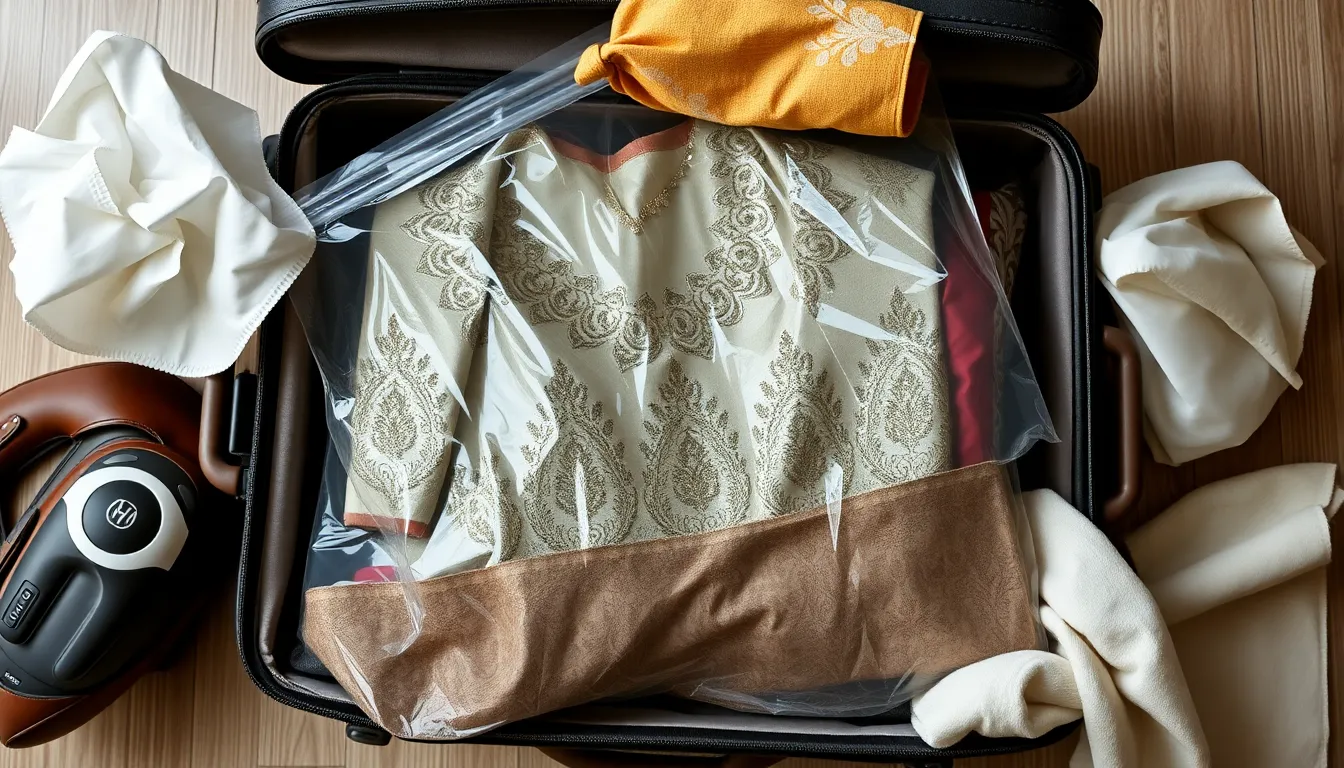
When we’re rushing to pack for a last-minute wedding invitation, we need smart strategies that protect our lehenga while maximizing space. These proven techniques ensure our precious garments arrive wrinkle-free and ready to wear.
Space-Saving Compression Techniques
Vacuum-sealed bags become our best friend when we’re dealing with limited luggage space. We can compress our lehenga by 70% while keeping it completely wrinkle-free during transport. This technique works perfectly for lightweight fabrics like georgette and chiffon.
Layered folding maximizes our packing efficiency by folding the lehenga from side seam to side seam first. We then fold it in half twice more to create a compact bundle that fits easily in standard suitcases. This method reduces wrinkles significantly compared to random folding.
Garment compression bags with one-way valves allow us to remove excess air without damaging delicate embellishments. We simply place our lehenga inside and push out the air manually for a space-saving solution that doesn’t require a vacuum.
Rolling technique works exceptionally well for plain or lightly embellished lehengas when we need maximum compression. We roll from the waistband down, securing the rolled bundle with soft fabric ties to prevent unraveling during travel.
Multi-Purpose Packing Items
Tissue paper serves multiple functions in our emergency packing arsenal by protecting embellishments and filling empty spaces in our luggage. We use acid-free tissue to prevent color bleeding while creating cushioning layers between different garments.
Portable steamers eliminate wrinkles instantly upon arrival, making them essential for last-minute travel situations. These compact devices weigh less than 2 pounds and can refresh our entire lehenga in under 10 minutes.
Soft muslin cloths act as protective barriers between embellished sections while doubling as cleaning cloths for quick touch-ups. We can also use them to wrap delicate accessories like jewelry and hair ornaments.
Breathable garment bags with multiple compartments allow us to organize our complete wedding outfit in one place. High-quality bags protect against dust and moisture while keeping everything easily accessible.
Essential Touch-Up Kit
Small sewing kit with matching threads becomes crucial when we discover loose sequins or beads after travel. We pack needles, thread colors that match our lehenga, and a few spare beads for emergency repairs.
Fabric refresher spray removes any musty odors that develop during compressed packing while freshening the fabric naturally. This works particularly well for lehengas that have been stored in vacuum-sealed bags.
Portable iron or handheld steamer provides last-minute smoothing power for stubborn wrinkles that resist other methods. We choose models with adjustable temperature settings to protect delicate fabrics.
Stain removal pen handles unexpected spills or marks that might occur during travel or pre-wedding activities. We select pens specifically designed for delicate fabrics to avoid damage to our lehenga.
Seasonal Packing Considerations for Wedding Lehengas

Wedding lehengas demand specialized packing approaches that adapt to seasonal challenges and environmental factors. Different weather conditions require unique protection strategies to preserve these precious garments throughout the year.
Summer Wedding Fabric Care
Store your lehengas in cool, dry environments away from direct sunlight to prevent color fading and fabric deterioration. Humidity during summer months can cause discoloration and mildew growth on delicate fabrics like silk and chiffon.
Air out your stored lehengas periodically in indirect sunlight to eliminate trapped moisture and refresh the fabric naturally. This gentle exposure prevents musty odors without subjecting the garment to harsh UV rays that damage embroidery threads and fade vibrant colors.
Control moisture levels by choosing storage locations with consistent temperature and low humidity. Attics and upper closets often become too hot during summer, making basement storage or climate-controlled rooms better options for preserving fabric integrity.
Wrap lehengas in breathable muslin cloth rather than plastic covers that trap heat and create condensation. Cotton wrapping allows air circulation while protecting against dust and insects that become more active in warmer weather.
Monsoon Protection Strategies
Elevate storage areas above ground level to protect lehengas from potential flooding and rising moisture during heavy rains. Basements and low-lying storage spaces become particularly vulnerable during monsoon season.
Add silica gel packets inside storage containers to absorb excess humidity that penetrates even well-sealed spaces. These moisture absorbers work continuously to maintain dry conditions around your precious wedding garments.
Inspect storage spaces regularly for signs of water leaks, dampness, or mold growth that can develop quickly in monsoon conditions. Monthly checks help identify problems before they damage stored lehengas.
Waterproof your storage containers using sealed boxes or adding plastic sheeting around cloth-wrapped lehengas as an extra barrier against moisture infiltration. This dual protection system ensures fabric stays dry even during extended rainy periods.
Position mothballs in muslin pouches within storage areas to repel insects that thrive in humid monsoon conditions. Lavender sachets and dried neem leaves mixed with cloves provide natural alternatives that smell pleasant while protecting fabrics.
Winter Storage Answers
Maintain controlled temperatures in storage areas to prevent fabrics from becoming brittle in extremely cold conditions. Avoid hot, dry spaces near heating systems that can cause silk and velvet to crack or fade.
Use cotton or muslin wraps exclusively instead of wool coverings that attract moths during winter months. These breathable materials provide adequate protection without introducing pest risks to your stored lehengas.
Prevent static buildup by avoiding synthetic storage materials that create electrical charge in dry winter air. Natural fiber wrapping maintains fabric softness and prevents damage from static electricity.
Schedule biannual maintenance every six months to air out stored lehengas and check for signs of pest activity or fabric deterioration. Winter storage periods often extend longer, making regular inspection crucial for early problem detection.
Professional dry cleaning becomes essential before winter storage, especially for heavily embellished lehengas that accumulate oils and residues. Clean garments resist pest attraction and prevent staining during extended storage periods.
Conclusion
We’ve covered comprehensive strategies to ensure your precious lehenga arrives at your wedding destination looking absolutely stunning. From selecting the right packing materials to mastering professional folding techniques these methods will safeguard your investment and give you peace of mind.
Remember that proper preparation is key to success. Whether you’re dealing with emergency packing situations or planning months ahead the techniques we’ve shared will help you transport your wedding attire safely across any distance or season.
Your wedding day deserves nothing less than perfection. By implementing these expert packing strategies you’ll step into your celebration with confidence knowing your lehenga looks exactly as it should – flawless and ready to make your special day unforgettable.
Frequently Asked Questions
What are the best materials for packing wedding lehengas?
Use breathable garment bags made of cotton or muslin to protect against dust and moisture. Avoid plastic bags that trap moisture and cause mildew. Choose full-length garment bags with reinforced zippers and transparent panels. Include acid-free tissue paper to prevent color bleeding, padded velvet-covered hangers to prevent stretching, and cedar hangers for moisture absorption and insect protection.
Which folding technique should I use for my lehenga?
Choose based on your lehenga type: use the Flat Lay Method for heavy, embellished lehengas; the Rolling Technique for lightweight fabrics; or the Layer-by-Layer Folding Strategy for complex sets with multiple pieces. Always use acid-free tissue paper between layers and store in breathable garment bags to maintain fabric integrity and prevent wrinkles.
How do I protect embellishments during packing?
Position embellished areas face up when packing and use soft cloth barriers between beaded or sequined sections. Layer acid-free tissue paper over delicate embellishments to prevent snagging. Avoid folding directly on embellished areas and ensure adequate padding around intricate beadwork to prevent damage during transport.
What’s the smart packing order for multiple wedding outfits?
Pack heavier lehengas at the bottom and lighter outfits on top. Place the most important outfit (usually the main ceremony lehenga) in the most protected position. Use separate compartments or bags for each outfit when possible. Keep accessories in designated pouches and maintain a strategic layering system to prevent crushing delicate fabrics.
How should I pack lehengas for international travel?
Choose high-quality portable garment bags designed for Indian wedding wear. Check airline policies for carry-on restrictions and consider shipping valuable pieces separately. Take photographs of each garment and keep purchase receipts for insurance purposes. Use compression techniques wisely to save space while maintaining garment integrity during long-distance travel.
What are the best emergency packing hacks for last-minute weddings?
Use vacuum-sealed bags for space-saving compression while keeping garments wrinkle-free. Employ layered folding techniques with tissue paper barriers. Pack multi-purpose items like portable steamers, fabric refresher spray, and breathable garment bags. Create an essential touch-up kit with a small sewing kit, stain removal pens, and fabric care products for unexpected issues.
How do seasonal conditions affect lehenga packing?
Summer requires cool, dry storage with breathable muslin wraps to prevent moisture and fading. Monsoon protection needs elevated storage, silica gel packets, and waterproof containers against humidity. Winter storage requires controlled temperatures, natural fiber wraps, and regular inspections to prevent pest activity. Professional dry cleaning before seasonal storage is recommended for optimal garment preservation.
What should I do immediately after reaching the wedding destination?
Remove lehengas from protective bags immediately upon arrival to allow air circulation. Use professional garment steamers to remove any travel wrinkles – never use direct heat or iron on delicate fabrics. Hang garments properly using padded hangers and allow them to breathe in a clean, dry space before the ceremony.


